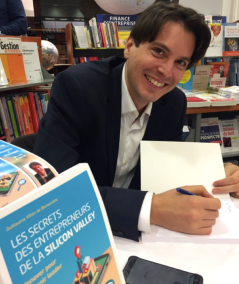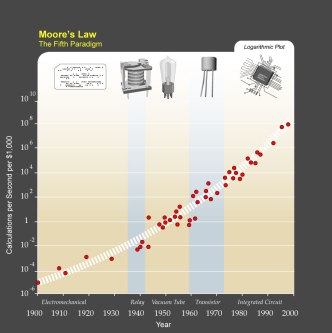Guillaume Villon de Benveniste is a sharp innovation consultant, and blogger at the Innovation and Strategy blog. He recently published ‘Secrets from Silicon Valley’s Entrepreneurs: innovate to become a leader‘, and we had an interesting discussion about his book, and some chosen pieces.

NB: What is the origin of your book, the ‘reason why’ you started writing it?
Guillaume Villon de Benveniste : I decided to start writing my book, Les secrets des entrepreneurs de la Silicon Valley, upon returning from a trip in California. While, in France, the mood is to reduce costs and boost operational efficiency, I was amazed to see how an innovation-economy produces exceptional value:
- Today, investors find approximately 60 companies whose value equals $1 billion pre-Initial Public Offering (IPO).
- An additional 180 companies reach a pre-IPO value of 500 million dollars.
- Google, Apple, Facebook and Amazon, often referred to as GAFA, make up a valuation equal to CAC 40 companies, France’s top 40 companies which were created about 100 years ago. GAFA companies boast an average age of 18 years old. In less than 20 years, the Silicon Valley created as much shareholder value as the top 40 companies in France have in the last hundred years.
- The Silicon Valley is creating 58,000 jobs a year in an area comprising 3 million individuals. Unemployment sits at 4.2 percent while average annual earnings reach $115,000, according to the 2015 Silicon Valley Index.
The French economy could learn a lot from the Silicon Valley.
NB: Who are the targeted readers of your book, and what practical tools can they take way?
Guillaume Villon de Benveniste : The book targets:
- Entrepreneurs;
- Innovation executives;
- Managing directors;
- Financial executives.
The reader can take away multiple practical tools:
Tool n°1: the meaning of innovation
First of all, the most fundamental tool to be taken away deals with the very meaning of innovation. I show that innovation involves an invention that finds a market. It carries multiple implications on the allocation resource process:
- How many resources are allocated to identify the client’s pain point and find a market?
- How many resources are devoted to building a solution that will meet the identified problem?
In France, Tradition teaches us to hire engineers and turn them into innovation project directors. Considering that engineers rather stick to building technical solutions than understanding clients, we’ve developed a trend in creating inventions that nobody buys. Examples abound: Numergy, Quaero… Steve Blank, the cofounder of the Lean Startup innovation practice, suggests that 50% of the innovator’s time should be dedicated to meeting with prospective clients in order to understand their daily lives and address their most pressing problems.

I guess this is the first practical tools innovators can get out of the book includes the following questions:
- How much time are innovators’ spending with their clients?
- How many innovators, in your innovation team, enjoy a marketing and sales background rather than a technical background?
- What people are making the decisions in innovation investment? What’s their background? How does technical skill balance out against client skills?
If French innovators could learn from my book that focusing on client pain points is critical to succeeding at innovation, then, we would improve our innovation success rates drastically.
Tool n°2: understanding the market from the client’s perspective
The second tool that innovators can get out of the book involves understanding the market from the client’s perspective. Consumers show no interest in products per se. They “hire” products in order to achieve a specific result. I mention a man trying to listen to music. I show that his experience in listening to music gets simpler, more accessible, more reliable, easier, cheaper and faster over time as technology and product forms morph.

So the goal for any innovator would be to assess how he can use technologies to simplify the consumer’s daily life. I go on and illustrates the Anthony Ulwick’s innovation opportunity algorithm which comes out of this detailed consumer observation.
Tool n°3: the law of accelerating returns
The third tool that I describe in the book includes the Law of Accelerating Returns. I’ve noticed that in the last few years, in France, transhumanism and The Singularity have sparked interest. But I regret that I pursued the philosophical implications rather than business ones.
When Ray Kurzweil talks about the Law of Accelerating Returns, he’s putting forth a theory of economic growth based on exponential technological capacity.
He believes that this Law remains fundamental to the digital economy. In other words, while the Industrial Revolution is powered by tools that improve on a linear basis, their digital equivalent improve exponentially.
Now, you may wonder how these theoretical considerations tie into business practicality. The answer: Time-To-Market. In the early 2000, Jean-Marie Messier, CEO of Vivendi, bet on the convergence of content and networks. The consumer would search for information and listen to music on his phone.
In many ways, it was a visionary move but turned out 10 years ahead of its time – to early. The networks could not support anyone listening to music on a phone, and existing software didn’t make searching for information a consumer-friendly experience. Bottom line: a loss of 13.6 billion euros in 2002.
Had Jean-Marie Messier referred to the Law of Accelerating Returns, he could have pinpointed when, in the future, there would have been sufficient bandwidth to enable his vision.

So my tip to any innovator is the following:
- When you have found a novel solution to address a specific client problem, be sure that there is a technological capacity to make it happen today.
- If that’s not the case, then estimate at what point, in the future, you will get to the necessary technological capacity.
4 Finally, the fourth practical tool involves creative abilities
I talk about cross-fertilization which is the cognitive ability to establish novel links between different worlds. For example:
- if you associate the consumer goal of “wanting to listen to music” and the “hard-drive technology of 100 MB,” then you get to a digital music player like the iPod.
- If you associate the consumer goal of “wanting to listen to music” to a “hard drive capacity of 1 GB stored in the cloud” then you get to streaming music.
In other words, each and every single innovation comes from associating a specific technology to what clients are trying to get done. One can summarize it in the table below:
| What consumers are trying to get done | Available technologies | Coss-fertilization |
| wanting to listen to music | hard-drive technology | Digital musical players like the iPod |
| wanting to listen to music | hard drive capacity stored in the cloud | Online music streaming websites like Deezer |
So this pretty much sums up what the reader can get out of my book in terms of practical tools:
- a new way of looking at the resource allocation process;
- a fresh understanding of consumers;
- an ability to succeed at the Time-To-Market challenge;
- in the cognitive ability to create novel combination between a technological assets and consumer needs.
NB: I found the chapter about ‘profits and how a market segment is under-covered’ very accurate. I guess it opens the door to Uberization as well, does it? In the consumer market, is there a segment which is clearly under-covered? What could be the next big disruption for you?
Guillaume Villon de Benveniste : Yes, as you indicate Nicolas, the chapter can provide some analysis as to why Uber is performing so well at the expense of established taxi companies. Uber simplifies the consumer experience at very specific moments:
- ordering a cab;
- waiting for the cab;
- enjoying the cab ride;
- paying;
- sharing one’s experience.
Uber does this better than established taxi companies. That’s why they are taking market share.

You ask about what could be the next big disruption. We’re living in a time of profound change but if I were to choose just one disruption I would probably go with Blockchain. Blockchain is a distributed database which keeps data records. It shows the potential to disrupt banks by offering currency exchanges and remittances, peer-to-peer transfers, trading platforms, data storage. Blockchain is in many ways the next internet as it’s distributed power provides better accountability than banks.
A second disruption will come from the fact that the connected population will double by 2020. That’s several billion individuals participating in the internet economy: sharing ideas, posting blog articles and videos, offering their services…
Companies that leverage Blockchain technology to address the needs of the newly connected several billion population are taking hold in a promising market.

NB: You write about ‘Silicon Valley Entrepreneurship Secrets’: do you notice innovation waves ‘beyond Silicon Valley’? What is your view on frugal / jugaad innovation?
Guillaume Villon de Benveniste : Many innovation waves rest beyond Silicon Valley. But, to meet the economic challenges we must face in France, we need to go to follow an innovation practice which can lead to profound industrial renewal. In 1900, France experienced a golden age which is often referred to as “La Belle Epoque”: 100% of CAC 40 companies originated between 1873 and 1913.
While we succeeded in creating industry giants during the Second Industrial Revolution, we still need to create industry giants in the Third Industrial Revolution. Jugaad innovation has really captured our imagination with bikes that cleans roads, water bottles which are used as spray. However, I doubt that it provides the depth to create the fundamental renewal we need in France.
Silicon Valley has stayed at the forefront of innovation for the last 50 years. This demonstrates an ability to replicate successful innovation, and take a world-leading leadership positions in very different market segments.
However Tel Aviv does offer an interesting example of innovation leadership. Despite, a small domestic market they fostered startups like Waze. Innovators must think global right from day one. We have much to learn from Israel in France.
NB: Did you follow a lean process starting with an MVP, and then test, learn, and iterate to complete your innovation book?
Guillaume Villon de Benveniste : Great question! In Running Lean, Ash Maurya, the author, shows how he used the Lean Startup methodology in order to create the cover of his book. Although his editor suggested that he go forth with a conventional cover, however, he decided to proceed with the cover that tested successfully.
What I find fascinating in the Lean Startup approach is that as you’re testing your product with a consumer base you’re also, in an indirect fashion, promoting your product.
Now, to get to your question: no I did not use a formal Lean Startup approach in order to write my book. However I did rely heavily upon the Lean Startup philosophy in order to select the content which would most appeal to my readers.
Let me tell you how I proceeded. As you know Nicolas, I’m the author of The Innovation and Strategy Blog. I’ve written about 230 articles over the last 3 years. I’ve noticed that:
- Some attract recurring traffic over time.
- Others arise interest only momentarily.
- Finally, a third, less successful type, only gets limited attention, despite my time and effort to make worthwhile.
So I decided to create my table of contents based on what gains the most traction with my audience over time.
This explains much of the spin of the book. I chose to talk about the Silicon Valley in a very specific way. I did not want to discuss a collection of novel startups or breakthrough technologies. Why? Simply because in 2 to 3 years from now these novel startups may go bankrupt, turn into industry leaders or get acquired by a Fortune 500 company. They will be history.
If an author is able to produce content which remains relevant in the next 10 to 20 years, then he’s setting the grounds to getting recurring sales which will produce much better results than any ephemeral sales peak. In the end, the market will be the final judge of my book’s relevance in time.

Thank you very much for inviting me on your blog, Rapid Innovation in digital time, Nicolas! I’m looking forward to continuing our conversations.



2 Comments